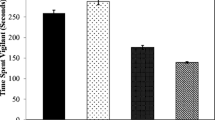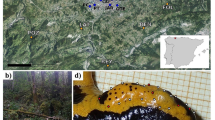Abstract
The caridean shrimp Hippolyte californiensis Holmes locates its host plant, the eel grass Zostera marina, visually, discriminating it on the basis of its form. Using models of the plant, the form-specific sign stimuli optimally releasing the host-selection response were investigated. Shrimps preferentially approached dark forms presented against a lighter background. The more a form contrasted with the background, the higher was its stimulatory value. Shrimps showed differential responses to solid forms of varying shape, preferring a stripe-like rectangle in a vertical orientation. Rectangular forms 50° (visual angle) or more in height and between 12° and 20° in width were maximally stimulating. Patterns of several vertical stripes had a greater releasing value for the approach response than a solid rectangle form of optimal dimensions. The greater the spatial frequency of a striped pattern, the reater was its attractiveness. Shrimps discriminated patterns of stripes whose elements were as small as 2° wide, giving an estimate of their visual acuity. Along with the relative contrast, the most important stimulus parameters of striped patterns are the continuous, straight form of the edges and their vertical orientation. It is postulated that the scototactic response of H. californiensis to relatively large, dark, solid forms is involved in the distant detection of clumps of eel grass. At closer range, the eel grass plants are then discriminated on the basis of the stripelike pattern of the leaves.
Similar content being viewed by others
Literature Cited
Ache, B.W. and D. Davenport: The sensory basis of host recognition by symbiotic shrimps, genus Betaeus. Biol. Bull. mar. biol. Lab., Woods Hole 143, 94–111 (1972)
Barry, C.K.: Experimental analysis of habitat selection in epiphytic shrimps of the genus Hippolyte in California. Ph.D. Dissertation, University of California, San Diego 1973
Dixon, W.J. and F.J. Massey: Introduction to statistical analysis, 288 pp. New York: Mc Graw-Hill 1957
Fricke, H.-W. und M. Hentschel: Die Garnelen-Seeigel-Partnerschaft — eine Untersuchung der optischen Orientierung der Garnele. Z. Tierpsychol. 28, 453–462 (1971)
Jacobs-Jessens, U.F.: Zur Orientierung der Hummel und einige anderer Hymenopteren. Z. vergl. Physiol. 41, 597–641 (1959)
Jander, R. und M. Schweder: Über das Formunterschei dungsvermögen der Schmeissfliege Calliphora erythrocephala. Z. vergl. Physiol. 72, 186–196 (1971)
—: Das Strauch-spezifische Perceptor-System der Stabheuschrecke (Carausius morosus). Z. vergl. Physiol. 70, 425–447 (1970)
—: Die Bedeutung von Streifenmustern für das Formsehen der roten Waldameise (Formica rufa L.). Z. Tierpsychol. 20, 1–9 (1963)
Kinosita, H. and A. Okajima. Analysis of shellsearching behavior of the land hermit crab, Coenobita rugosus H. Milne Edwards. J. Fac. Sci. Tokyo Univ. (Sect. 4) 11, 293–358 (1968)
McCann, G.D. and J.C. Dill: Fundamental properties of intensity, form and motion perception in the visual system of Calliphora phoenica and Musca domestica. J. gen. Physiol. 53, 385–413 (1969)
Meyer, H.W.: Visuelle Schlüsselreize für die Auslösung der Beutefanghandlung beim Bachwasserläufer Velia caprai (Hemiptera, Heteroptera). Z. vergl. Physiol. 72, 260–297 (1971)
Rabaud, E.: Recherches sur l'adaption et le comportement des pagures. Archs. Zool. exp. gén. 82, 181–285 (1941)
Reese, E.S.: The behavioral mechanism underlying shell selection by hermit crabs. Behaviour 21, 78–126 (1963)
Tinbergen, N. and A.C. Perdeck: On the stimulus situation releasing the begging response of newly hatched herring gull chicks (Largus argentatus argentatus Pont.). Behaviour 3, 1–39 (1951)
Voss, Ch.: Über das Formsehen der roten Waldameise (Formica rufa Gruppe). Z. vergl. Physiol. 55, 225–254 (1967)
Watermann, T.H., C.A.G. Wiersma and B.M.H. Bush: Afferent visual response in the optic nerve of the crab Podopthalmus. J. cell. comp. Physiol. 63, 135–155 (1963)
Author information
Authors and Affiliations
Additional information
Communicated by O. Kinne, Hamburg
This study was supported by the Marine Life Research Group of Scripps Institution of Oceanography and represents a portion of a dissertation submitted in partial satisfaction of requirements for the Ph.D. at the University of California, San Diego.
Rights and permissions
About this article
Cite this article
Barry, C.K. Role of form vision in habitat selection of the grass shrimp Hippolyte californiensis . Mar. Biol. 26, 261–270 (1974). https://doi.org/10.1007/BF00389256
Accepted:
Issue Date:
DOI: https://doi.org/10.1007/BF00389256




